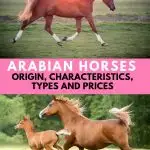Recognized as one of the oldest and most influential of all horse breeds, most modern horses alive today have an Arabian ancestor somewhere in their DNA. Beautiful, elegant, versatile, swift, and enduring in more ways than one, the Arabian horse is truly special.
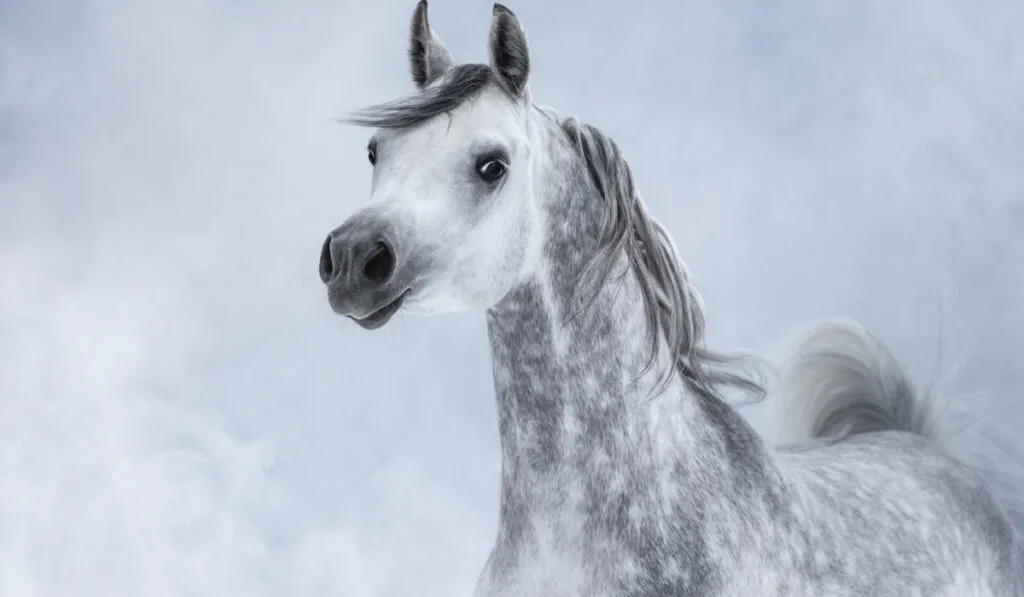
Table of Contents
Origin of the Arabian
The exact origins of the Arabian horse are still shrouded in mystery. Named for the Arabian peninsula in the Middle East, the Arabian horse was refined by the migratory Bedouin people over thousands of years. Bred to be swift, loyal, and elegant, these horses influenced nearly all of the breeds of horses that we have today.
The Bedouin tribes began selectively breeding horses in arid desert conditions around 5,000 years ago. Only the strongest horses could adapt to such an extreme climate – the result? A prized equine companion with an elegant and refined appearance, large lung capacity, and a strong, compact body. These horses could swiftly carry riders over thousands of miles of desert, and they are still known for that lasting endurance today.
The Bedouin tribes maintained pure bloodlines by meticulously passing down breeding records orally through generations, and by naming their horses with suffixes of “son” and “daughter”. Mixing bloodlines with other desert breeds was forbidden – Arabians were to remain “asil” (pure).
To protect their horses from harsh weather or rogue thieves, tribesmen would bring their horses into their tents with them. While fostering such a close relationship with their people, Arabians developed a good sense and friendly nature – traits that still exist in modern-day specimens of the breed.
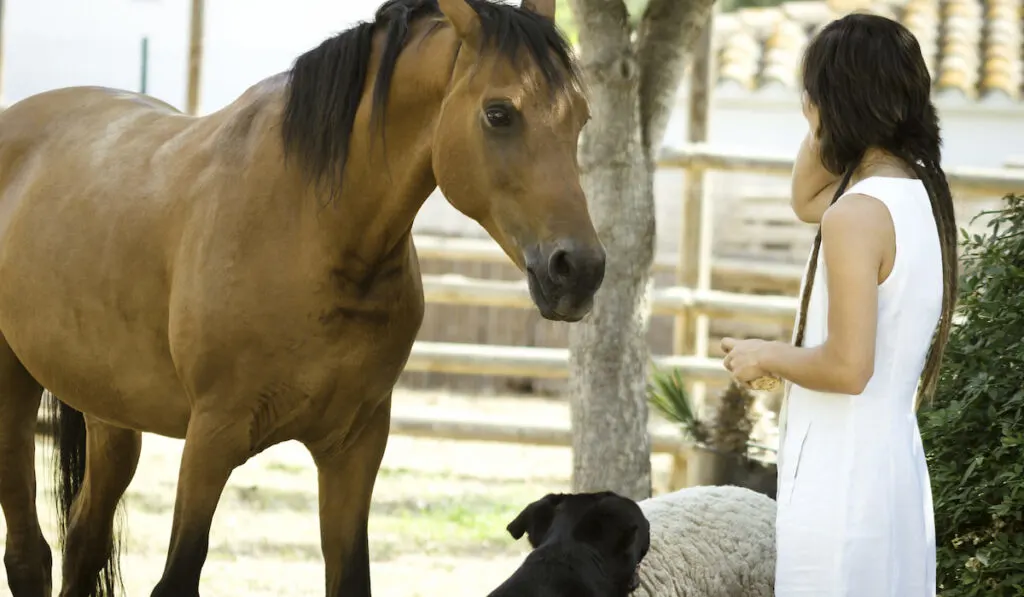
Five Basic Families of the Arabian Breed
Horses were selectively bred into five distinct families, each with distinguishing characteristics. Legend says that Muhammed, the great prophet of Islam, tested his horses to find the most loyal and swift, and the results were five mares of these foundation types:
| Type | Characteristics |
|---|---|
| Kehilan | Deep chests, “masculine” in power and size, measured up to 15 hands, short heads with broad foreheads, mostly grey or chestnut. |
| Seglawi | Refined elegant “feminine” appearance, faster, fine bone structure, long faces and necks, up to 14.2 hands, usually bay. |
| Abeyan | Refined appearance, longer back, smaller – up to 14 hands, generally gray with more white markings. |
| Hamdani | “Plain” appearance, athletic and more masculine build, thicker boned, straight head and lacking a large “Jibbah”, large – around 15.2 hands, gray and bay. |
| Hadban | Smaller version of the Hamdani, big-boned and muscular, known for their gentle nature, 14.3 hands, brown or bay. |
Horse enthusiasts and breeders have always specialized their horses for versatility, a practice that continues to this day.
Different sub-types of Arabians:
There are several different sub-types of modern Arabians:
- Crabbet Arabians: In 1878, Lady Anne Blunt opened an Arabian breeding program at Crabbet Park in England. Dedicated to preserving the ancient Bedouin breeding traditions, she ensured that her horses would have only the best and purest bloodlines possible. These horses were selected for soundness and athleticism, and some say they lack the traditional mesmerizing Arabian aesthetic. Nevertheless, these horses continue to have a widespread influence on the breed around the world.
- Polish Arabians: In the 16th century, Arabians arrived in Poland as spoils of war from Turkey. They are most often described as the seglawi and kuhailan types. Now, Polish Arabians are popular in racing. Polish racehorses have also served as test subjects for several studies about the effects of music on horses, which gives us greater insight into horse behavior as a whole.
- Egyptian Arabians: Depictions of Arabian-like horses appeared in ancient Egyptian tombs thousands of years ago. Egyptian Arabians trace back to breeding programs of Egyptian royalty – specifically Viceroy Mohammed Ali and his grandson Abbas Pasha I. These horses possessed the pure “asil” blood of the Bedouin horses, and still remain regal and impressive today.
- Russian Arabians: Russian Arabians are bred for racing. Their roots trace to Count Orlov, the man for whom the Orlov trotter was named. Russian Arabians have been improved with French, Crabbet and Polish bloodlines and molded into impressive athletes since 1921.
- Shagya Arabians: The Shagya Arabian developed in the Austro-Hungarian empire – it most often appears in the Czech Republic, Austria, Hungary, Germany, and surrounding countries. These horses are generally taller and bigger-boned than purebred Arabians due to cross-breeding and influences from other breeds. They excel at competitive sports, especially jumping, dressage and endurance.
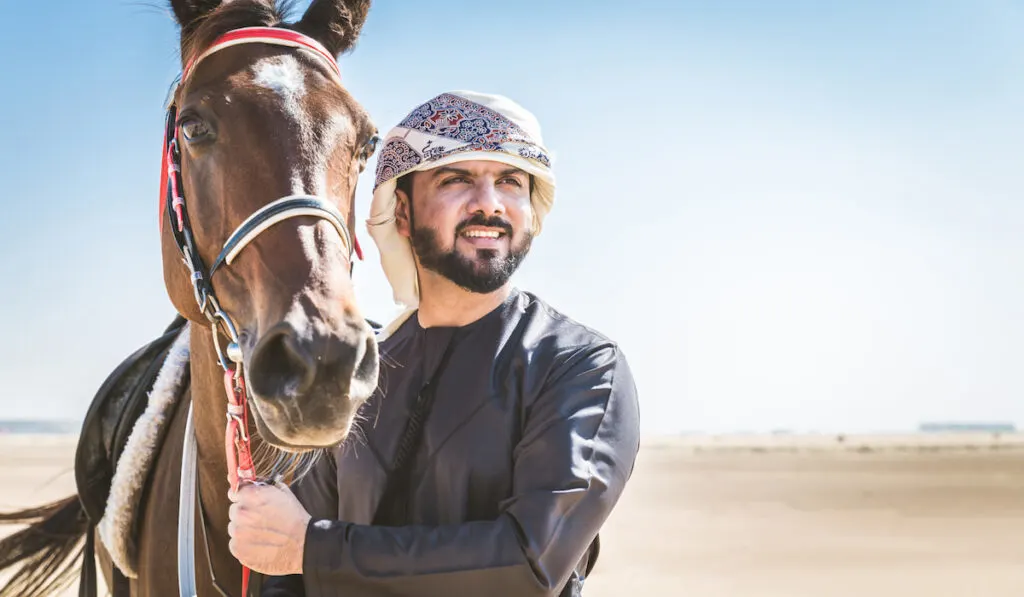
Arabians and Islam
As chivalry gained traction in Europe in the middle ages, the Middle East had its own version: furusiyya. Furusiyya is “the historical Arabic term for equestrian martial exercise” in the 10th-15th centuries. (source) A scientific discipline, practitioners of furusiyya focused on three categories: horsemanship (veterinary practices, riding, horse care), archery, and “charging with the lance”.
Arabians made excellent war horses. The Bedouins would select their most loyal and efficient mares for raiding parties, and sneak into enemy camps. Mares were prized over stallions because of their talent for silence – mares don’t give away a soldier’s position.
In the 7th century, the Muslim prophet Mohammed was “instrumental in spreading the Arabian’s influence around the world:”
“He instructed his followers to look after Arabians and treat them with kindness. He said that special attentions should be paid to the mares because they insure (sic) the continuity of the breed. He also proclaimed that Allah had created the Arabian, and that those who treated the horse well would be rewarded in the afterlife.”
As Islam spread, Arabians were used in the fulfillment of the jihad (the struggle against enemies of Islam), and these horses were woven into the fabric of the culture. The purebred Arabian was prized –regarded as a gift from Allah.
Arabians Across the Globe
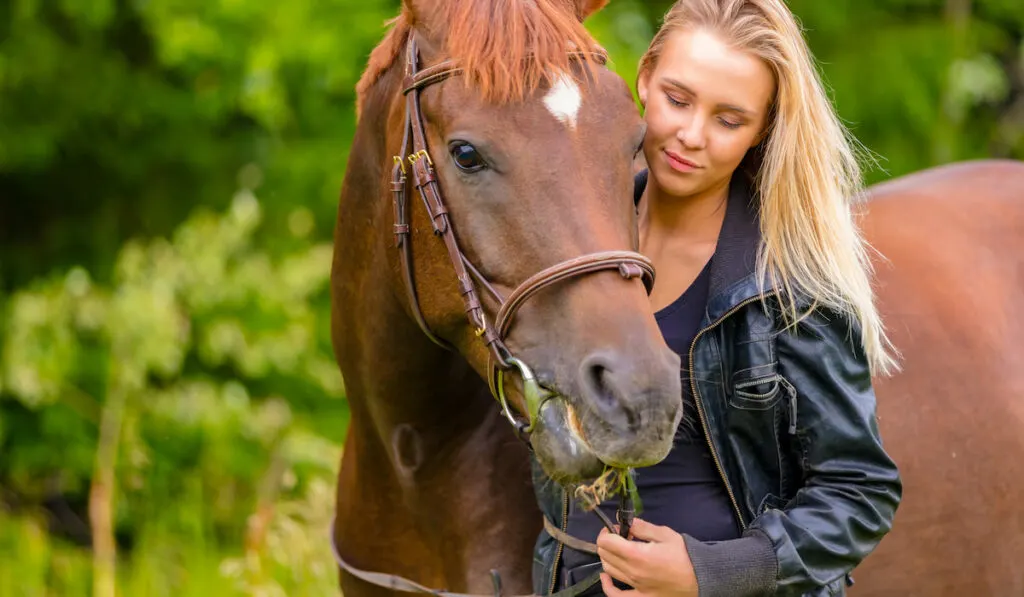
The Darley Arabian, Byerley Turk, and Godolphin Arabian became the foundation stallions for the thoroughbred breed – 93% of Thoroughbreds can trace their lineage back to these three horses.
In America, George Washington bred his Arabian to improve his cavalry mounts. In 1893, Arabians appeared at the Chicago World Fair, and interest in the breed grew from there!
Crossbreeds
Arabian blood is almost always used to refine other breeds, and there are some recognized crossbreeds with their own registries:
- Anglo-Arab: The Anglo-Arab is the product of breeding Arabians to Thoroughbreds. The result is a strong, fast, lean horse that excels in events such as show-jumping, endurance, and eventing. An Anglo-Arabian must possess at least 12.5% Arabian blood.
- National Show Horse: The National Show horse is a product of Arabian and American Saddlebred horses. Graceful and lean, these horses excel at saddle seat – they’re flashy movers with a lofty trot. National Show Horses must have 50%-99% Arabian blood.
- Quarab: The Quarab is a cross between a quarter horse and an Arabian. There are three recognized types: straight/foundation, stock, and pleasure. Each type will have a different purpose, but these horses are generally athletic, muscular and versatile – appearing in a variety of disciplines.
Some other popular crossbreeds include:
Morab: A Morgan and Arabian crossbreed.
Pintabian: An Arabian crossed with a paint horse, resulting in a horse with 99% Arabian and tobiano coloring.
Welara: A Welsh pony and Arabian cross – a hardy, athletic pony.
Arabian bloodlines are also used to improve many other established breeds, especially for performance – such as the Trakhener.
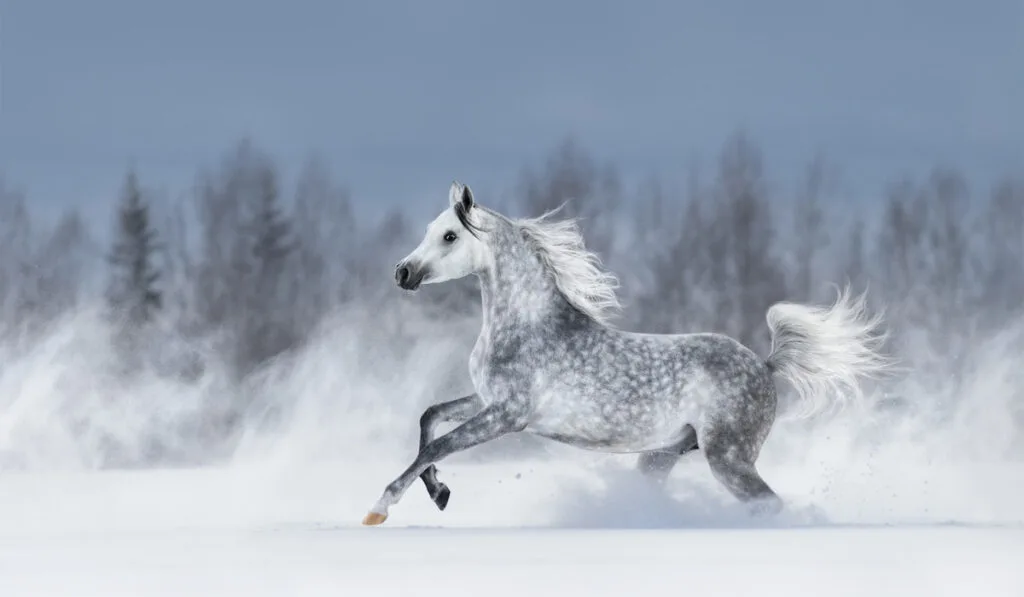
Registration Requirements:
The Arabian Horse Association has strict requirements for registered purebred Arabians, just as the Bedouins did thousands of years ago. Both parents must be registered purebred Arabian, and all horses seeking entry into the registry are subjected to a DNA test to confirm.
However, crossbred Arabians may be entered into a separate AHA registry under “half-Arabian,” as long as one parent is a purebred Arabian. If one parent is a thoroughbred (registered with the Jockey Club), the offspring may be registered as an Anglo-Arab.
Arabian Horse Characteristics
Arabians are lean, strong, well-bred machines. Designed for endurance as raiding horses in the harsh conditions of the Saudi Arabian desert, these horses have been categorically refined over thousands of years of selective breeding. The result is a horse that exudes grace and commands attention wherever he goes:
“The purebred Arabian horse is striking. An Arabian’s most identifiable characteristics are its finely chiseled head, dished face, long arching neck and high tail carriage. Its entire appearance exudes energy, intelligence, courage and nobility. Every time an Arabian moves in its famous “floating trot,” he announces to the world his proud, graceful nature.”
From arabian.org
Originally used as war horses rather than pack animals, Arabians developed several characteristics that set them apart from other horses.
Height:
The Arabian is a relatively small horse, standing between 14.1 and 15.2 hands tall. They are considered horses, rather than ponies, even if they measure shorter than the standard cutoff of 14.2 hands.
Weight:
The Arabian horse generally weighs between 800 and 1000 pounds. Smaller horses consume fewer resources, which is essential for survival in a harsh desert climate. They also have dense bones, which enables them to carry heavier loads than other light horses.
Unique Characteristics:
Several specific characteristics define the Arabian breed:
- Head: Arabians have delicate, refined heads that are preferably marked by a distinctive “dished” profile – the area between the forehead and the nose is slightly concave. They have large, expressive eyes, wide foreheads, small muzzles, and large nostrils.
- Neck: Their necks are long and arched, giving them an elegant and graceful appearance.
- Back: Arabians have short backs – in fact, many of them are missing vertebrae! Having a short back allows a horse to draw power from its hindquarters and puts a spring in its step.
- Croup: Relatively broad and flat croup; this also allows the horse to draw power from the hindquarters and provides a smooth ride.
- Tail: Arabians have a naturally high tail carriage giving them a proud look at all times.
Missing Bones
Arabians have fewer bones than other horses. Many possess 17 ribs, as opposed to the standard 18. They also only have 5 vertebrae instead of 6, and 16 tail vertebrae instead of 18. Because of this, they have shorter and more compact bodies than other breeds – these features are excellent for speed and agility.
Colors
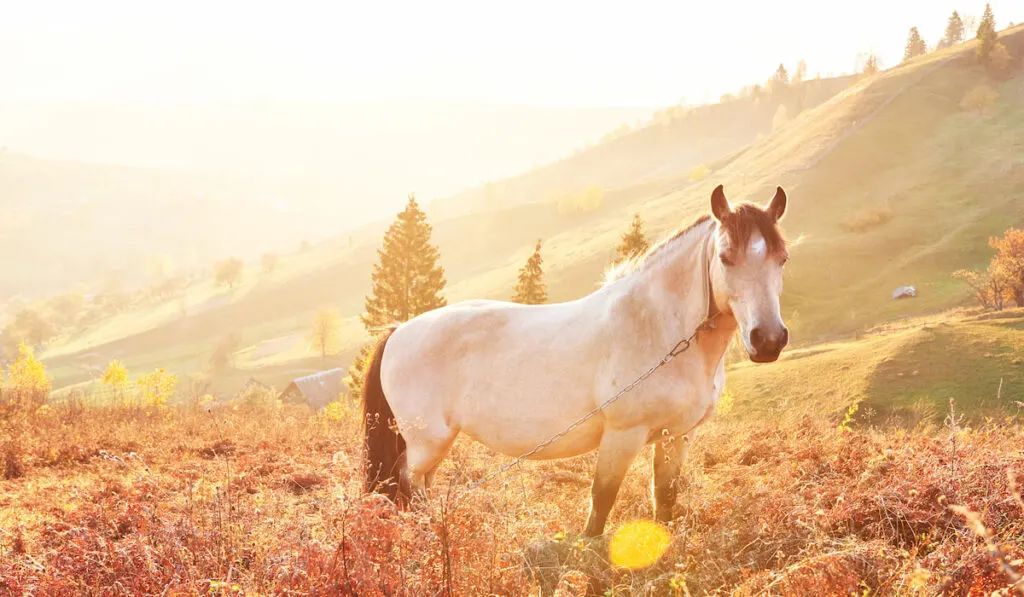
Arabians can come in any color, but to be registered they must be bay, gray, chestnut, or roan (sabino or rabicano, not “true roan”).
Sometimes, an Arabian in a rare color will appear:
- White with pink skin and dark eyes: Most white or gray Arabians have black skin, to protect them from the sun.
- Sabino is a roan-like spotting pattern: horses have a large percentage of “high white” above knees, spotting on legs belly, or face.
- Rabicano: heads and legs are solid-colored, and the horse doesn’t have intermingled white and solid hairs all over – only on midsection and flanks.
Registered purebred Arabians can never carry the “dilution” color genes such as dun, cremello, palomino, bucksin, pinto, or the leopard-complex gene (this is responsible for Appaloosa spotting).
To the Bedouins, palomino horses were considered bad luck, and spotted horses looked like livestock. Black horses would also not have fared well in the desert climate, for they would have become overheated easily. These characteristics were usually bred out, but they occasionally appear in modern Arabians today.
Temperament
These horses were bred to be loyal, intelligent, and friendly. As a “hotblooded” horse, they may be a bit more spirited than other breeds, but children may show stallions in-hand during competitions – this is unusual, since stallions are known to be more temperamental or unpredictable.
Arabians have good temperaments, good “horse sense”, and trust easily. They make excellent family horses, and they would be suitable for a beginner with the right training and supervision.
Value
Arabians were exceptionally valuable to the Bedouins. A good mare used for war was priceless – she would never be sold, but only given as a precious gift. It is believed that these horses were mostly used for riding, since camels and donkeys were the common beasts of burden at the time.
Only the highest quality stallions were kept by the tribes; a horse had to prove its value, and mares were better suited for raiding parties.
During the “Arabian craze” of the second half of the 20th century, wealthy people were drawn to the elegance and beauty of Arabians just as kings and sultans were drawn to them thousands of years ago.
Some of the most expensive Arabians sold for millions of dollars!
- Marwan Al Shaqab: The Qatar royal family was offered $20 million for this champion, and turned it down. His stud fee is $20,000, and he produces around 50 foals a year.
- Padron: This stallion was “syndicated” for $11 million in 1983 (this means that not one owner sold him, but rather sold breeding rights and “shares” of the horse).
- NH Love Potion: A champion halter mare sold for 2.5 million, but the buyer defaulted on the purchase and the seller took the mare back.
- Moniet al Saharaf: The highest selling Egyptian Arabian stallion fetched $10 million.
- Naborr: Singer and Arabian breed enthusiast Wayne Newton purchased this Russian stallion in 1969 for $150,000. The average price for a champion Arabian by 1985 was $450,000!
There are still Arabian horses in the Middle East that fetch hundreds of thousands or millions of dollars, but your average American Arabian sells for around $5,000. This is an affordable price point, especially for those looking for a pleasure mount or casual riding companion.
Disciplines
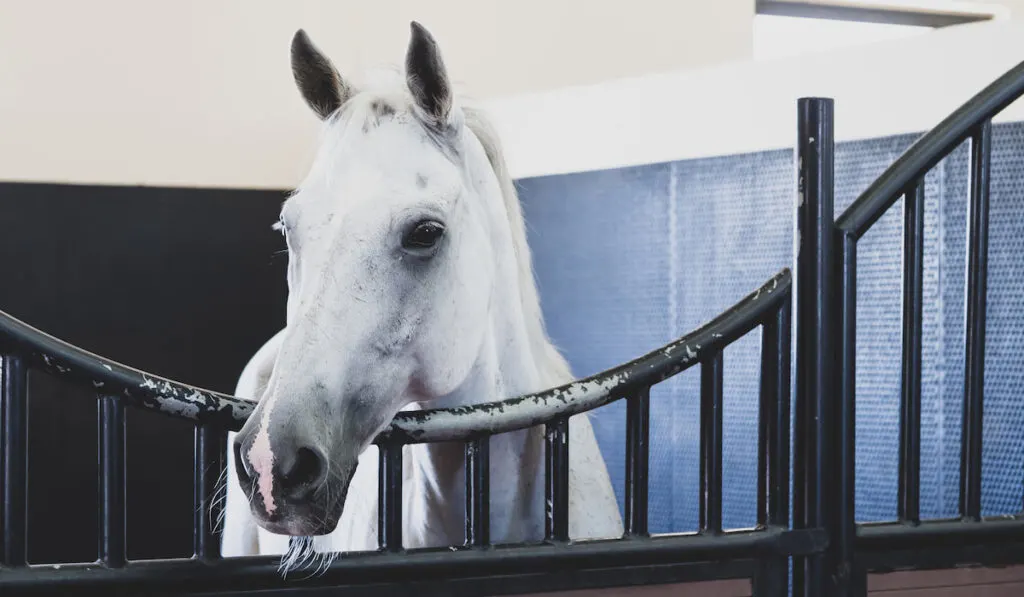
Arabians are the undisputed champions of endurance riding. Built for speed and stamina, these horses can cover 25, 50, or 100 miles of difficult mountain terrain in a single day. In their desert homeland of Qatar, Arabians compete in timed races – covering 75 miles in just 8 hours! Thousands of years of selective breeding have given the Arabian the tools it needs to succeed: large nostrils and chests, well-proportioned frames, and a competitive spirit.
These versatile horses also participate in many other competitive events, in both Western and English disciplines including:
- Halter classes
- Dressage (both English and Western)
- Saddle seat, park and pleasure
- Hunter & Western pleasure
- Costume classes
- Driving
- Jumping
- Cutting
- Roping
- Reining
- Trail riding
- Gymkhana
Arabians compete and succeed in almost every equestrian discipline. They’re true athletes!
Arabian Horse Racing
While Thoroughbreds are the dominant racing breed in the US, Arabian racing is popular in Egypt, Poland, and Russia. Many horses are raced on the track to get a gauge of the horse’s speed and competitive nature, but are quickly exported for other disciplines. Horses that are retired from racing can lead fulfilling lives afterward as endurance, performance, or pleasure mounts.
Is an Arabian the horse breed for you?
Arabians have unparalleled grace, beauty, and athleticism. Their versatility and exceptional pedigrees make them a favorite horse breed throughout the world. If you’re looking for a spunky, intelligent, and swift little horse for your next mount, consider an Arabian!
Related Posts
- Choosing the Right Size Horse for Your Height / Weight
- 4 Best Fly Masks for Horses
- 13 Different Breeds Where You Can Find All Black Horses
Resources:
- https://www.arabianhorses.org/discover/arabian-horses/#Breed%20Standard
- https://www.arabianhorses.org/discover/arabian-horses/

